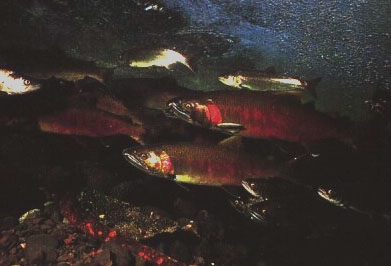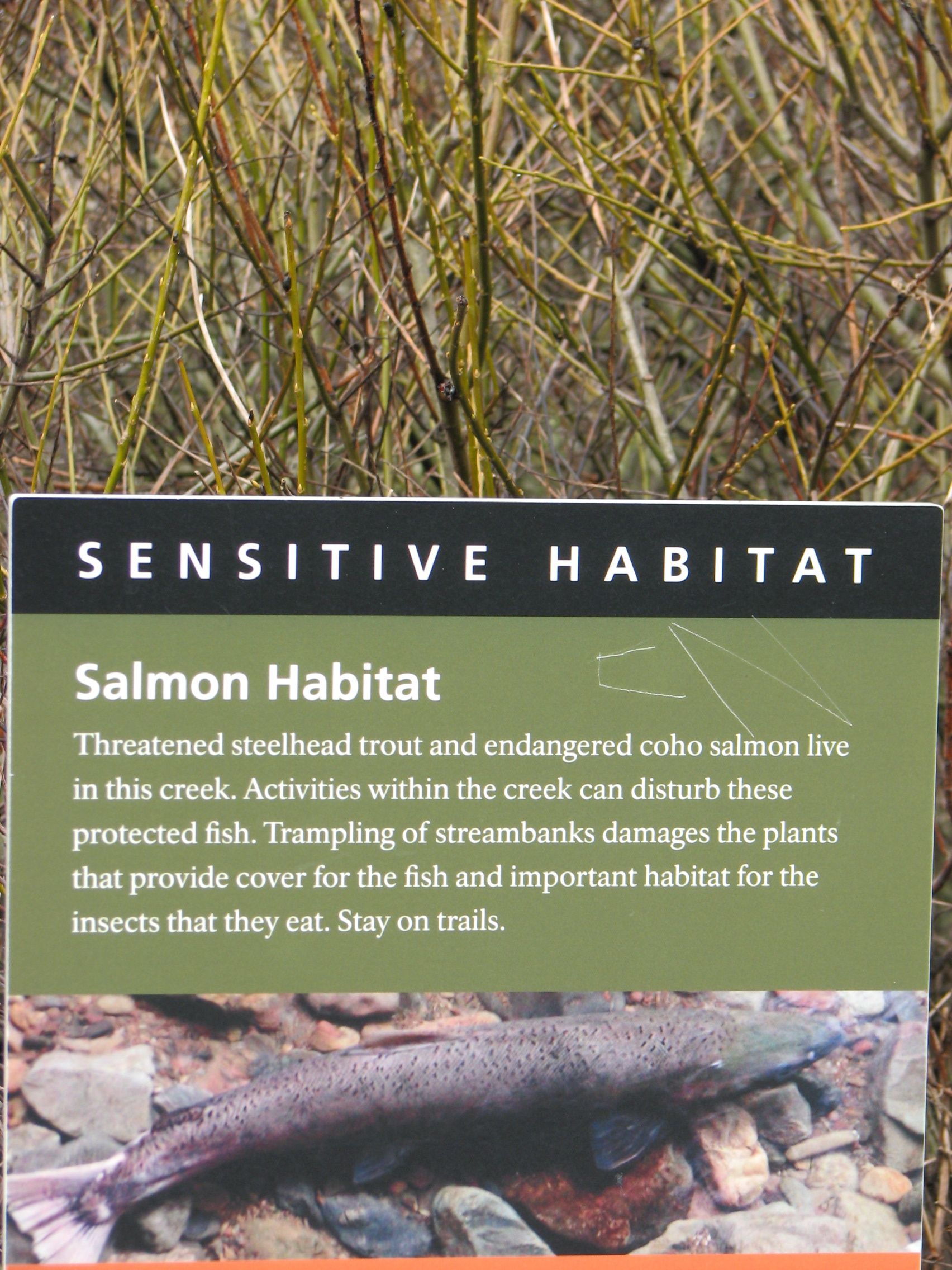I. How did the wild frontier shape American attitudes about nature in two divergent ways?
| January 26 | How do environments influence people? | Write about your reactions to Introduction to Siry. | |
|---|---|---|---|
| Effective Strategies to describe places are a Narrative. | Coastal wetlands were seen as obstacles and not the very productive fish and wildlife nurseries that they are. | Did you identify a conflict? How does Preservation differ from Conservation? |
Journal entry electronically submitted on Wiki by the end of the week? |
Class Method
To write for five minutes without stopping:
What is a river mouth and how does it differ from other types of geography?
Prompt
What are the parts of the introduction?
Can you find the thesis of the Introduction?
What are the two stories involved in the book?
===========
Internet
- Text for the class.
- available on Blackboard™.
- Post a response to on class Wiki
Backgrounds
"One must lose a minnow to catch a salmon."
The above French proverb is a very human centered view of what is in origin a natural condition. Fish are a natural resident of wet places and as such the character of the rivers and streams from the high Mountains of Western California are home to exquisite varieties of fish, but none more confusing, yet revealing than the spring salmon. From the Coastal Ranges, the Southern Cascade Range and even the northern Sierra Nevada Mountains ample water from rain and snow melt drive spring water levels so high that fish find there way back from the sea to the rivers form which they were conceived. This never ending cycle of the salmon's life is but one example of the focus of environmental history that differs from political and economic history and informs other forms of historical inquiry.
Salmon habitat a sign that is a focus for describing the levels or layers of land because this landscape is a formative influence on this fishery and is of "critical concern" for the environment this course will be describing.
"Many Landscapes we Fight Over"

Northern California is {was} salmon river landscapes. | All landscape is a set of layered scales.
Why look at a narrative structure?
The narrative structure exercise addresses 3 student learning outcomes:
2 Verbally present from a prepared script artistic and photographical portrayals of our national land-use patterns or landscape changes across time.
3 Active participants should use & explain an analogy in writing portraying the specific qualities of settlement patterns including, urbanization, agriculture, or use of natural resources.
4 Demonstrate in writing defining qualities of different values in America with respect to the ecological measures of land, air, and water resources.
Concepts to look for:
Coevolved diversity
Conservation
tidal seas
Stewardship
Biotic communities
Estuary
Oyster reefs
aesthetic, economic, & scientific arguments
protection
productivity
"Progressive conservation"
reclamation
Swamplands Acts
integrity of biogeochemical cycles
tidewater navigation
interstate commerce
tidal wetlands
preservation
public trust of sovereign lands
wastelands
fisheries
wildlifeland-use
Forests and water supplies as watersheds & primary resources
Identify in the Introduction, the parts of this narrative structure
Narrative History Structure Reading carefully to discover meaning J. V. Siry, Ph.D
"Writing is an extreme privilege but it's also a gift. It's a gift to yourself and it's a gift of giving a story to someone."
Amy Tan
Narrative structure of Introduction: Marshes of the Ocean Shore.The thesis is _______________________________________________________.
1.The Precondition
“Stems from the conviction that?
2. The Buildup:
3. The Main Event:
4. The main events' Meaning
5. The wind-down or dénouement:
6. The Outcome
(i.e.) modernity has _____________________________________
7. Consequences
For example: “...historic patterns in American development of estuaries reveal conflicting assumptions concerning the role of natural resources . . ..”
J. V. Siry, Marshes of the Ocean Shore, page 6.
to these suggestions:
Use parts of the text to complete this exercise.
Narrative History Structure Reading carefully to discover meaning J. V. Siry, Ph.D
"Writing is an extreme privilege but it's also a gift. It's a gift to yourself and it's a gift of giving a story to someone." (Amy Tan, novelist.)
Narrative structure of Introduction: Marshes of the Ocean Shore.
The thesis is [see pages 5 & 6 or page 7].
1.The Precondition
River mouths have a peculiar history revealing a tension in national attitudes about land. page. 3.
“Stems from the conviction that?" Marshes, especially tidal marshes, are not wastelands.
2. The Buildup:
The slow realization -- overcoming bias, commercial incentives, and engineering to value:
birds, fisheries, sanitation, scenery, oceanography & ecology of rivers at the sea
3. The Main Event:
Reclamation as conservation versus tidal marsh preservation
was only resolved by adopting an "estuarine preservation ideal."
4. The main events' Meaning
A truer test of conservation is in contested grounds; such as marsh lined river mouths.
5. The wind-down or dénouement: Confirmation by Odum at Sapelo Island about productivity
The productivity of estuarine marshes makes them essential for healthy seas & their extent along the flood-plain makes for well protected shorelines.
6. The Outcome The preservation of tidal marshes was less than hoped for in 1968.
* i.e.) modernity has _ promoted engineering to transform and science to better understand rivers.
7. Consequences "today a series of state and federal estuarine refuges exist as quiet testimony to the ideals, efforts and commitment of local conservation groups, planners, engineers, and scientists. These advocates possess a resolute maturity in asserting that some places must be set aside . . . " page 17.“...historic patterns in American development of estuaries reveal conflicting assumptions concerning the role of natural resources . . . .”
J. V. Siry, Marshes of the Ocean Shore, page 6.
Definitions
Writing (link to pages to view) – http://myweb.rollins.edu/jsiry/Art_of_Good_Writing.html
Modernity-- A term used by writers to mean (post 1490), a term used to designate both a historical period, as well as the collection of related particular socio-cultural norms, attitudes and practices that arose in post-medieval Europe and have developed since to distinguish contemporary society from earlier times.http://myweb.rollins.edu/jsiry/Challenges_modernity.html
society – a “tightly closed group.” Octavio Paz, The Labyrinth of Solitude, page 16. Hunters are part of society.
Reality, “that is the world that surrounds us.” Octavio Paz, Labyrinth, page 20. An estuary is a reality!
culture as “a complex of values created and shared in common.” Octavio Paz, Labyrinth, page 26.
http://myweb.rollins.edu/jsiry/StoryLine.html
Joseph Siry, Marshes of the Ocean Shore, 1984, (College Station, Texas: Texas A & M University Press, 1984), pp, 1-23.
Mary Austin, The Land of Little Rain, 1903 (New York: Dover Press, 1996) pp. 1 - 16.




